![]()
![]()
![]()
Use LEFT and RIGHT arrow keys to navigate between flashcards;
Use UP and DOWN arrow keys to flip the card;
H to show hint;
A reads text to speech;
30 Cards in this Set
- Front
- Back
|
Endocrine Organs
|

|
|
|
Two major types of endocrine gland systems
|
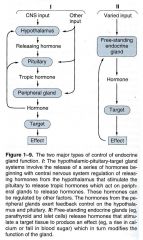
- ptential for negative or sometimes positive feedback
|
|
|
Diurnal Rhythm of cortisol secretion
|
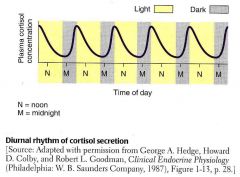
Involvement of clock proteins in suprachiasmatic nucleus of hypothalamus
+ Input from pineal gland melatonin cortisol lowest at midnight - and highest just before waking - bright light is the most useful thing when you are jet lagged |
|
|
Types of Intercellular Communication
|
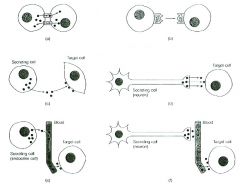
- paracrine
- synaptic - endocrine - autocrine hypothalamus to pituary ; means the signal is not diluted by being circulated throughout the body |
|
|
Endocrine vs Synaptic Signaling Pathways
|

|
|
|
Prohormones
|
EXTRA level of control
= inactive precursors of hormones EXAMPLES: • proinsulin • vitamin D • testosterone (DHT active at prostate and skin) •thyroxine |
|
|
PHEROMONES
|
Are also chemical messengers
BUT! • are carried in AIR • are produced by one animal to affect another animal Thus are not true hormones |
|
|
TYPES OF HORMONES
|

|
|
|
Chemical nature of hormone affects
|
•Mechanism of synthesis
•Storage •Transport in blood •Mechanism of interaction with target cells eg Hydrophillic drugs get across cell membranes readily but require transport binding to globulins to get around the body - peptides can move around no problem but need to bind specific receptors for cell entry |
|
|
PRODUCTION & SECRETION: Peptides
|

|
|
|
PRODUCTION & SECRETION: Amines
|
catecholamines – in granules attached to binding protein
hydrophilic thyroid hormone – as part of thyroglobulin in colloid of thyroid follicles lipophilic |
|
|
PRODUCTION & SECRETION: Steriods
|

|
|
|
Transport in blood:
protein binding |

|
|
|
3 general means by which hormones elicit biological response
|

|
|
|
Receptors
Why so complex? |
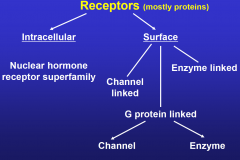
Signal amplification
Signal interaction Signal stabilization |
|
|
Adrenalin MOA
|

|
|
|
Growth Hormone Secretion Regulation
|

|
|
|
Nuclear receptor
superfamily |

|
|
|
Steroid hormone-receptor
Mechanism of action |

|
|
|
Hormones may bind to more than 1 type of receptor
|
and we can make drugs that only binds to a specific receptors ths eliciting only the required hormonal response
|
|
|
Hormone actions may be
- permissive - Synergistic - antagonistic |
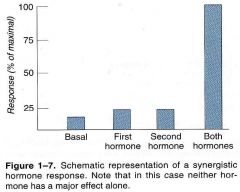
Permissive eg thyroid h and catecholamines
Synergistic eg follicle stimulating h & testosterone: Antagonistic –eg anti-estrogens, anti-androgens |
|
|
Termination of signal
|
1. Hormone metabolised
2. Intracellular signals metabolised eg cAMP degraded by phosphodiesterases to 5’AMP phosphatases remove phosphate group 3. Receptor recycling/degradation |
|
|
Pathway of receptor-mediated endocytosis and receptor recycling
|

|
|
|
What can go wrong?
|

|
|
|
Jansen’s metaphyseal chondrodysplasia
|
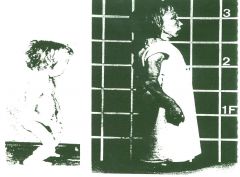
Jansen’s metaphyseal chondrodysplasia at age 5 (left) and 22 (right) – due to constitutive activation of parathyroid hormone/PTH- related protein receptor – affects cartilage, especially
- His to arginine in the receptor making it always on |
|
|
Horomonal Responses Overview
|

|
|
|
Ix
|
1.Screening – is there hormone over or under-production?
2.Confirmation 1.Stimulation Test (confirm hormone underproduction) 2.Suppression Test (confirm hormone overproduction) 3.Imaging - only once biochemical localization achieved as endocrine organ “incidentalomas” commonly occur |
|
|
Pituitary Disease
|
Structure:
•-Generally pituitary lesions extend upwards and can compress the optic chiasm, causing bitemporal hemianopia •-However, if they extend laterally (less common), they can involve cranial nerves •- Rarely, they may invade the sellar floor •-As part of the mass effect, they can cause headache •Function: •Consider the consequences of over or underproduction of the various hormones |
|
|
Pituitary Hormones
|

|
|
|
History of pituitary disease
|
Structural effects
•Headache •Visual disturbance •Cranial nerve abnormalities Hormonal effects Underproduction or overproduction or combination |

